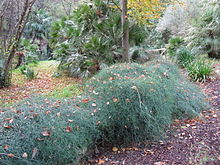| Ephedra altissima | |
|---|---|

| |
|
Scientific classification
| |
| Kingdom: | Plantae |
| Clade: | Tracheophytes |
| Clade: | Gymnospermae |
| Division: | Gnetophyta |
| Class: | Gnetopsida |
| Order: | Ephedrales |
| Family: | Ephedraceae |
| Genus: | Ephedra |
| Species: | E. altissima
|
| Binomial name | |
| Ephedra altissima | |
| Synonyms [2] | |
|
Chaetocladus altissima (Desf.) J.Nelson | |
Ephedra altissima is a species of Ephedra that is native to the western Sahara ( Morocco, Algeria, Tunisia, Libya, Chad, Mauritania), and also to the Canary Islands. [2] [3] [4]
The species is cultivated as an ornamental plant and medicinal plant.
Habitat
This plant is located in Algeria, Chad, Libya, Mauritania, Morocco, Spain, Tunisia, and the western Sahara. It can be viewed at elevations between 10 meters to 700 meters above sea level. [5]
Characteristics
This plant is described as a green, dioecious shrub. Each flower is either male or female needing two different for seed formation. It prefers well drained, loamy soil in an area with direct sunlight. Once established the plant is hardy, resistant to drought and lime. [6] The leaves bud in an opposite fashion with the plant being green all year. A shrub often found on rocky calcareous slopes. Flowering time is between February–May. Fruiting time is between April–May. The ripe female cone is eaten by animals.
Taxonomy
It was originally described by René Louiche Desfontaines in 1799 and placed in section Pseudobaccatae (=sect. Ephedra), "tribe" Scandentes. This being due to the similarity in stem and leaf structure and organization.
In 1996 Robert A. Price classified E. altissima in section Ephedra without recognizing a tribe. [7]
Threat
As a result of the plant having such a widespread location, there are no specific major threats. This plant was last assessed by IUCN on August 13, 2010, with a least concerned rating. Due to the non-concerned attitude toward the endangerment of the species, no seeds have been collected as an ex situ conservation measure. It is not known to occur in any protected areas. [5]
Medicinal uses
The members of this genus have alkaloid ephedrine which are integral in the treatment of asthma and other related respiratory issues. By using the entire plant and not just the stem it has been observed, as compared to isolated ephedrine, to have few side effects. This is used to treat symptoms not cure respiratory issues. Young plants have the best potency if ingested raw while older plants are best to be dried and used in a tea. [6]
Varieties
- Ephedra altissima var. altissima - Morocco, Algeria, Tunisia, Libya, Mauritania, Canary Islands
- Ephedra altissima var. tibestica Maire - Tibesti Mountains of northern Chad
References
- ^ Bell, A.; Bachman, S. (2011). "Ephedra altissima". IUCN Red List of Threatened Species. 2011: e.T201672A9161344. doi: 10.2305/IUCN.UK.2011-2.RLTS.T201672A9161344.en. Retrieved 19 November 2021.
- ^ a b Kew World Checklist of Selected Plant Families
- ^ Barry, J. P. & Celles, J.S. (1991). Flore de Mauritanie 2: 360-550. Centre Regional de Documentation Pedagogique, Nice.
- ^ Dobignard, A. & Chatelain, C. (2011). Index synonymique de la flore d'Afrique du nord 3: 1-449. Éditions des conservatoire et jardin botaniques, Genève.
- ^ a b "The IUCN Red List of Threatened Species". IUCN Red List of Threatened Species. Retrieved 2018-12-04.
- ^ a b "Ephedra altissima - Desf". pfaf.org.
- ^ Price, R. A. (1996). Systematics of the Gnetales: A review of morphological and molecular evidence. International Journal of Plant Sciences, 157(6): S40-S49.
External links
![]() Media related to
Ephedra altissima at Wikimedia Commons
Media related to
Ephedra altissima at Wikimedia Commons
